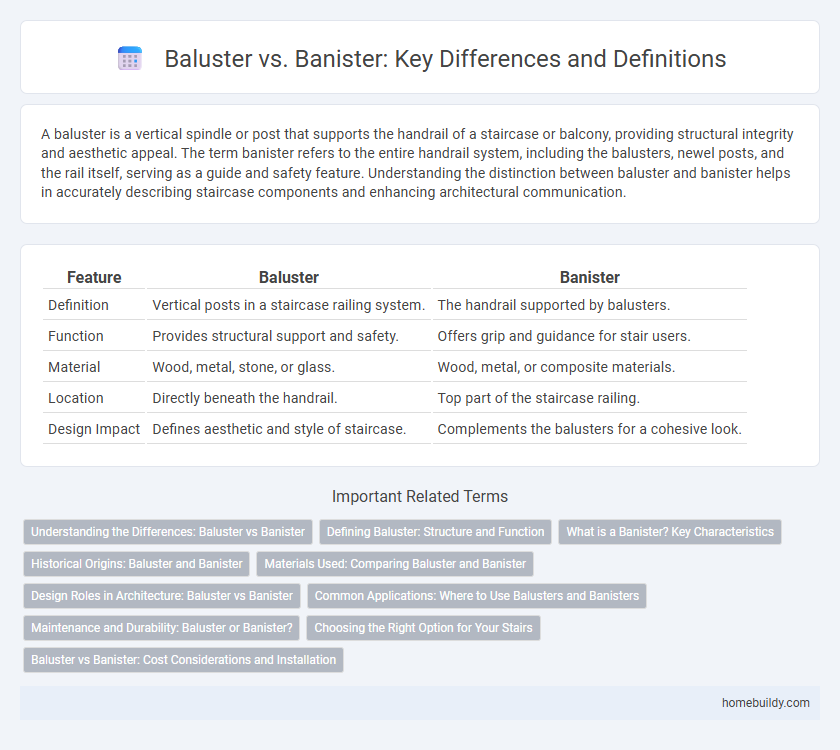A baluster is a vertical spindle or post that supports the handrail of a staircase or balcony, providing structural integrity and aesthetic appeal. The term banister refers to the entire handrail system, including the balusters, newel posts, and the rail itself, serving as a guide and safety feature. Understanding the distinction between baluster and banister helps in accurately describing staircase components and enhancing architectural communication.
Table of Comparison
| Feature | Baluster | Banister |
|---|---|---|
| Definition | Vertical posts in a staircase railing system. | The handrail supported by balusters. |
| Function | Provides structural support and safety. | Offers grip and guidance for stair users. |
| Material | Wood, metal, stone, or glass. | Wood, metal, or composite materials. |
| Location | Directly beneath the handrail. | Top part of the staircase railing. |
| Design Impact | Defines aesthetic and style of staircase. | Complements the balusters for a cohesive look. |
Understanding the Differences: Baluster vs Banister
Balusters are the vertical posts that support the handrail on a staircase, providing structural stability and decorative detail, while the banister refers specifically to the entire handrail assembly, including the balusters, rail, and newel posts. Understanding the distinction between a baluster and a banister is essential for accurate communication in architecture and interior design, as balusters are components of the banister system rather than synonyms. This clarity helps in specifying materials, designs, and installation requirements for staircases and railing systems.
Defining Baluster: Structure and Function
A baluster is a vertical molded shaft, square or rounded, forming part of a balustrade that supports the handrail on staircases or balconies. Unlike the banister, which refers primarily to the handrail itself, the baluster's main function is to provide structural support and safety, preventing falls. Balusters are often spaced evenly and crafted from materials like wood, metal, or stone, contributing both to the stability and aesthetic detail of architectural designs.
What is a Banister? Key Characteristics
A banister is the handrail component of a staircase designed to provide support and safety when ascending or descending steps. Key characteristics include a smooth, continuous surface for gripping and attachment to balusters or newel posts for structural stability. Unlike the baluster, which refers to the vertical posts, the banister functions primarily as the horizontal handrail guiding the user's movement.
Historical Origins: Baluster and Banister
Balusters originated during the Renaissance period, evolving from classical architecture where turned or carved vertical posts supported stair railings or parapets. Banisters historically refer to the handrail itself, stemming from the Old French term "balustre" linked to balusters but emphasizing the rail component rather than the vertical supports. The distinction highlights that balusters serve as the decorative or structural spindles, while banisters embody the continuous handrail guiding stair users.
Materials Used: Comparing Baluster and Banister
Balusters are primarily made from wood, metal, stone, or glass, offering structural support and decorative appeal in staircases, whereas banisters, often constructed from wood or metal, serve as the handrail component for stability and safety. Wood balusters provide traditional aesthetics, while metal and glass options offer modern, sleek designs that enhance durability and visual openness. Banister materials are chosen for ergonomic grip and wear resistance, complementing the baluster's design while ensuring functionality.
Design Roles in Architecture: Baluster vs Banister
Balusters serve as vertical supports that provide structural stability and aesthetic detail in staircases, balconies, and terraces, enhancing safety while contributing to design intricacy. Banisters function as the handrails that rest atop balusters, offering ergonomic support and guiding movement along stairs or ramps. Together, balusters and banisters form an integrated system essential in architectural design, balancing functionality with visual appeal.
Common Applications: Where to Use Balusters and Banisters
Balusters are primarily used as vertical supports in staircases, balconies, and terraces, providing safety and decorative detail. Banisters refer to the entire handrail assembly, including the handrail, balusters, and newel posts, commonly found in residential and commercial staircases. Understanding the distinction helps in specifying components for architectural design and construction projects.
Maintenance and Durability: Baluster or Banister?
Balusters, typically made from wood, metal, or stone, require regular maintenance such as cleaning, painting, or sealing to prevent wear and ensure long-lasting durability. Banisters, often constructed from solid wood or metal handrails, tend to have a smoother surface making them easier to clean and maintain over time. Choosing between baluster and banister for durability depends on material quality and upkeep frequency, with metal balusters and hardwood banisters offering superior longevity.
Choosing the Right Option for Your Stairs
Balusters are the vertical posts that support the handrail, while banisters refer to the entire railing system including the handrail and balusters. Selecting the right option depends on the architectural style and safety requirements of your stairs; balusters offer more customization in materials and design, enhancing the aesthetic appeal of the staircase. Choosing between a baluster-focused or banister-focused approach impacts both visual harmony and structural stability in stair design.
Baluster vs Banister: Cost Considerations and Installation
Balusters generally cost less than banisters due to their smaller size and simpler design, making them a budget-friendly option for stairways. Installation of balusters is typically quicker and less labor-intensive, which can reduce overall expenses and project time. Banisters, being larger and more complex, often require professional installation, increasing both material and labor costs.
baluster vs banister Infographic

 homebuildy.com
homebuildy.com